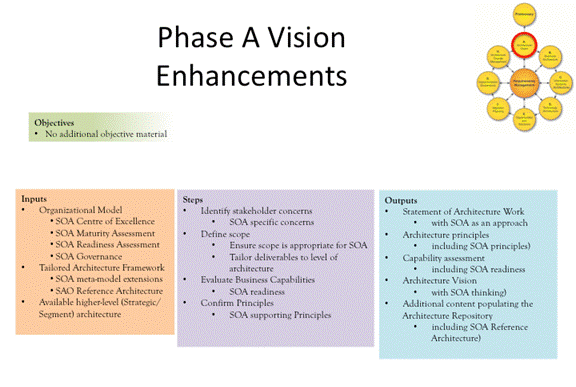The TOGAF Architecture Vision is a crucial component of the Architecture Development Method (ADM) within the TOGAF framework. It serves as a high-level summary of the changes that will result from the successful deployment of the Target Architecture. This guide will provide an in-depth look at the purpose, content, creation, and outputs of the Architecture Vision, along with practical examples to illustrate its application.
Purpose of the Architecture Vision
The Architecture Vision serves several critical purposes:
-
Stakeholder Agreement: It provides key stakeholders with a formally agreed outcome early in the ADM cycle. This ensures that everyone is aligned on the goals and expected outcomes of the architecture project.
-
Focus on Detail: It enables architects to focus on the necessary details to validate the feasibility of the architecture. By having a clear vision, architects can delve into the specifics without losing sight of the overarching goals.
-
Stakeholder Communication: It supports communication with stakeholders by providing a summary version of the full Architecture Definition. This helps in conveying complex architectural concepts in a digestible format.
-
Selling the Benefits: It provides the sponsor with a tool to sell the benefits of the proposed capability to stakeholders and decision-makers. A compelling Architecture Vision can garner support and buy-in from key individuals.
-
Alignment with Business Goals: It describes how the new capability will meet business goals, strategic objectives, and stakeholder concerns. This ensures that the architecture is aligned with the organization’s strategic direction.
Content of the Architecture Vision
The Architecture Vision typically includes the following content:
-
Problem Description: A detailed description of the problem, including stakeholders and their concerns, and a list of issues or scenarios to be addressed.
- Example: A retail company aims to improve its online sales. The problem description might include current challenges such as slow website performance, lack of personalized recommendations, and inefficient inventory management.
-
Objective of the Statement of Architecture Work: The goal of the architecture project, clearly articulated to guide the development process.
- Example: The objective could be to develop a scalable e-commerce platform that enhances user experience and integrates seamlessly with existing inventory systems.
-
Summary Views: Necessary views for the Request for Architecture Work and the Draft Business, Data, Application, and Technology Architectures. This often includes a Value Chain diagram and Solution Concept diagram.
- Example: A Value Chain diagram might illustrate the flow from customer interaction to order fulfillment, highlighting areas for improvement.
-
Mapped Requirements: A mapping of requirements to ensure that all business needs are addressed in the architecture.
- Example: Requirements might include the need for a mobile-responsive website, real-time inventory updates, and integration with third-party payment gateways.
-
Reference to Draft Architecture Definition Document: A reference to the detailed architecture definition document that provides a comprehensive view of the architecture.
-
Business Scenarios (Optional): Scenarios that illustrate how the architecture will support business processes.
- Example: A scenario might describe how a customer places an order online, tracking the process from browsing to checkout and delivery.
Creation and Development
The Architecture Vision is created in Phase A of the ADM. The process involves several key steps:
-
Establishing the Architecture Project: Defining the project’s scope, objectives, and boundaries.
-
Identifying Stakeholders, Concerns, and Business Requirements: Engaging with stakeholders to understand their needs and concerns.
-
Defining Scope: Clearly defining the scope of the architecture project to focus efforts and resources.
-
Confirming Architecture and Business Principles: Ensuring that the architecture aligns with established principles and business goals.
-
Developing the Architecture Vision: Creating the vision and articulating it through business scenarios.
-
Defining Value Propositions and KPIs: Identifying the value propositions of the Target Architecture and defining Key Performance Indicators (KPIs) to measure success.
-
Identifying Risks and Mitigation Activities: Assessing the risks associated with business transformation and planning mitigation activities.
-
Developing the Statement of Architecture Work: Creating a formal statement that outlines the architecture work to be undertaken.
Outputs of the Architecture Vision Phase

The outputs of the Architecture Vision phase include:
-
Approved Statement of Architecture Work: A formal document outlining the architecture work to be undertaken.
-
Refined Statements of Business Principles, Goals, and Strategic Drivers: Updated statements that reflect the outcomes of the Architecture Vision phase.
-
Architecture Principles: Principles that guide the development of the architecture.
-
Capability Assessment: An assessment of the organization’s capabilities to support the Target Architecture.
-
Tailored Architecture Framework: A framework tailored to the organization’s needs and context.
-
Architecture Vision: The final Architecture Vision document that summarizes the high-level architecture.
-
Communication Plan: A plan for communicating the Architecture Vision to stakeholders.
Business Architecture
The Business Architecture phase focuses on defining business processes in the detail required to support the architecture. This is especially important for new business processes that are introduced.
- Example: In the retail example, the Business Architecture phase might involve defining new processes for personalized customer recommendations, real-time inventory updates, and streamlined order fulfillment.
Conclusion
The Architecture Vision provides an integrated summary of Architecture Definitions, which in turn provide an integrated summary of Transition Architectures. It includes a high-level description of the final architecture that is envisaged, ensuring that all components of the architecture are aligned and cohesive.
By following this comprehensive guide, organizations can develop a robust Architecture Vision that aligns with business goals, engages stakeholders, and drives successful architecture projects.